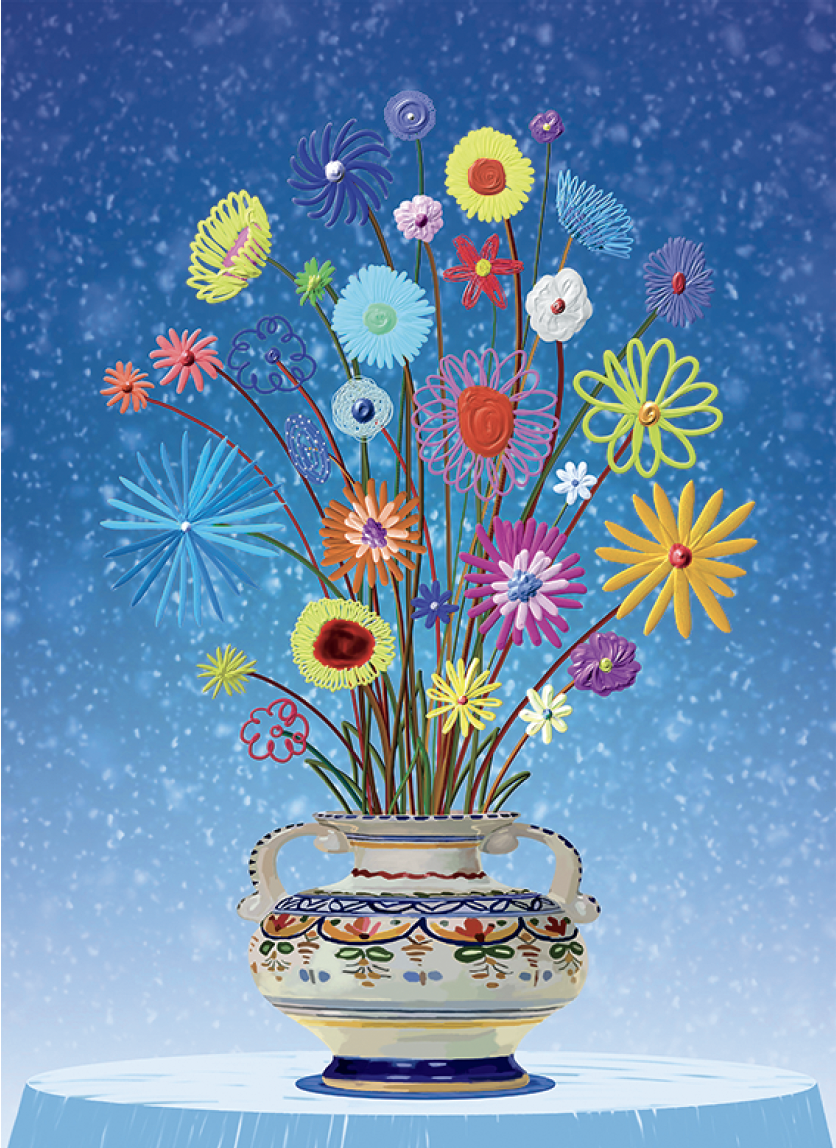Alex Livingston
At the opening of Alex Livingston’s “Flowers” at Studio 21 in Halifax, Nova Scotia, I was speaking with a local arts reporter when it became apparent that she thought she was looking at paint on canvas. Days later, while in the gallery taking notes for this review, I heard two women standing in front of the work, talking about it as if it were paint on canvas. In reality Livingston has presented us with six 50 x 43-inch framed pigment ink prints on Dibond. Livingston, who has been making paintings and teaching painting at NSCAD for the last 30 years, has been working digitally for a decade. The ambiguity concerning the nature of this work is the consequence of a convergence of the artist’s deep engagement with historical and contemporary painting and decades of digital influence on painterly production in general. These digital images were constructed in a manner that forefronts the codes of painting so clearly that they read like paint on canvas. A closer look at Flowers in Sunshine should serve to illustrate the point.

Alex Livingston, installation view, “Flowers,” 2017, Studio 21, Halifax. All images courtesy of the artist and Studio 21, Halifax.
Like many historical Dutch flower paintings, it is a central composition of flowers in a vase sitting on a table, round in this case, which occupies the bottom portion of the painting. The flowers are depicted in front of a cloud-filled sky, no middle ground. Upon closer inspection, the viewer can see that the flowers, which have a gestalt of naturalness about them, are playfully made up of deliberate mark making done with various digital “brushes” designed to impart the trompe l’oeil appearance of a three-dimensional textured brush stroke. The strokes that make up the flowers have a freshness to them, as if they are done once and left that way, probably indebted, in part, to the “undo” function available on any digital painting software. The flowers have a synthetic nature to them that they share with their Dutch predecessors. In the case of the historical Flemish flowers, there is a wonderful illusionism, and also a collage-based nature that is not as apparent today as it was to their first viewers. There was no refrigeration or airplane travel in the 17th and 18th centuries so the lavish and varied flower arrangements depicted by artists like Rachel Ruysch, containing flowers that bloom at different times, could never have existed. In the case of Livingston’s flowers, all of which are imaginary, the fine-grained digital illusion of texture and 3D form, and a digitally derived gestural freshness, are both synthetic.
The vase is addressed in a painterly way, seemingly wet into wet, and dark to light, a traditional oil painting technique. The table is rendered with subtle, striated, horizontal brush strokes. The shadow under the vase takes the form of swirling digital marks that would threaten to pop off the picture plane if their values weren’t precisely handled.
The sky is the most photo-based part of this work. The central composition, colour value choices and judicious treatment of edges allow for an integrated visual feel between the backgrounds and the sky, which belies the humorous lack of a middle ground and refers once again to the lack of middle ground in many Dutch flower paintings.

Springtime, 2017, pigment ink print on Dibond, 59 x 43 inches.
The digital influence on contemporary painting is ubiquitous, and the work flow, with few exceptions, is well established. Digital planning occurs at preliminary stages, and paint on canvas is the end product. The result is that many paintings refer to digital effects such as endless multi-coloured or three-dimensional brush strokes, extreme colour vibrancy, and evidence of blurring, smearing, liquifying and embossing filters. In a boomerang-like relationship, many of these effects were born of an effort to replicate analogue processes, but their digital manifestation radically broadened the limits of their analogue reference. This in turn pushed painters to develop new analogue techniques designed to emulate the expanded digital replication of the original analogue effects. This has proven to be a productive relationship for the craft of painting and an urgent one as artists who engage with the idea of Painting strive to understand their relationship with the digital world around them.
If there is a reigning force in the digital influence on painting today, it is the market, which still seems to hold the basic materials of painting—paint, canvas and linen— and its handmade origin as indispensable elements of the art objects it moves from owner to owner.
As I looked at Livingston’s work, what came first to mind was how the paintings would have been constructed if made with paint on canvas. At the same time, the paintings never let me forget that I was looking at a digital image. Livingston’s “Flowers,” steeped in the codes of painting, provide a fruitful model for the developing relationship between the digital and the analogue in contemporary painting. ❚
“Flowers” was exhibited at Studio 21, Halifax, from March 3 to March 29, 2017.
Mathew Reichertz is an artist and an associate professor in fine arts at NSCAD University.

